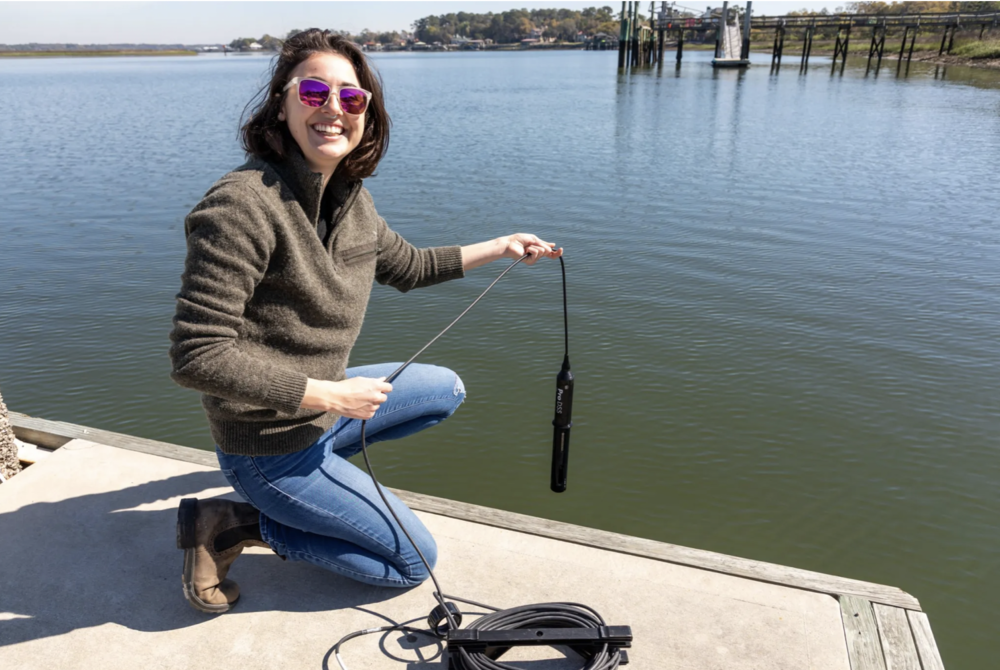
Caption
Mallory Mintz collecting water samples off the dock at Skidaway.
Credit: UGA Marine Extension and Georgia Sea Grant

Mallory Mintz collecting water samples off the dock at Skidaway.
Mary Landers, The Current
Green slime in Florida’s Lake Okeechobee and sickened sea lions on the California coast are two recent examples of harmful algal blooms making headlines.
This overproduction of algae is not something that has popped up much on the Georgia coast, though.
Researcher Mallory Mintz is a University of Georgia Skidaway Institute graduate student who is studying the ups and downs of algae growing in the Skidaway River in Savannah. She says there’s a good reason and a bad reason why a map of harmful algal blooms shows little in the 100-mile stretch from St. Marys to Tybee.
First the bad: “Generally Georgia isn’t necessarily monitoring it like Florida is, like South Carolina is, so we’re not seeing these blooms,” Mintz told an audience gathered to hear her speak at the UGA Aquarium on Skidaway Island last week.
And then the good: “So the Georgia Coast is a little bit special, right? We have those high tidal ranges. And that means that there’s high tidal flushing, so we’re getting a large influx of marine flood waters every day, (with) less nutrients.”
While Georgia’s high tidal range makes algal blooms less likely, they have occurred here, she noted. One happened in the Skidaway River in 2019 and is believed to be the cause of a sudden death of a crop of baby oysters, called spat, raised at the oyster hatchery right next door to the aquarium where Mintz gave her talk.
“They did a water change per usual, came back the next day, and it was 80% to 90% mortality of those little oysters,” she said.
The working hypothesis is that a type of algae called Akashiwo were the culprits. Akashiwo — the term is Japanese for “red tide” — is a genus of algae that share the same garlic-clove shape. Some Akashiwo produce a toxin, though the particular ones in the Skidaway do not.
“But they do produce that surfactant, that foam that I was talking about earlier, that can clump down bird feathers, and expose them to hypothermia. And it can literally clog the gills of oysters,” Mintz said.
Mintz, who is currently taking twice daily low tide samples of river water, is on the lookout for a bloom. If one occurs, she’ll have data from before, during and after the event. She’s hoping to be able to understand what genes might be turned on during those particular scenarios that allow Akashiwo to scale up quickly.
Hot weather generally encourages blooms, meaning more are expected with global warming. So does an influx of nutrients into a waterway, like fertilizer runoff from a farm or a sewage spill.
Mintz’s work is piggybacking off about two decades of data recorded regularly by volunteers at about a half dozen stations along the Georgia coast, including a robust group at Skidaway. They’re part of the UGA Marine Extension and Georgia Sea Grant’s phytoplankton monitoring network, its longest-running citizen science program, now in its 20th year.
Sandy Haeger is one of Skidaway’s citizen scientists; she also spoke at Mintz’s talk. Her neighbors recruited the fitness instructor and former elementary teacher to the National Phytoplankton Monitoring Network team more than a decade ago. She remembers how at her first phytoplankton training the equipment flummoxed her.
“They took us into the phytoplankton lab, gave us a microscope, gave us a prepared slide and said ‘Go for it,’” Haeger said. “I had chemistry about 50 years prior. I’m embarrassed to say this, I didn’t know how to use the microscope.”
She learned quickly. And though she found out there are “at least 80,000 types of these critters,” she learned to identify the most common ones in the Skidaway River.
“Why would they think that I could do something like this? I have no idea. But I’m forever grateful to both of them. It’s been an amazing experience,” Haeger said.
The knowledge gained from the volunteers led Mintz to her summer sampling schedule and could be key to warning the public, or the oyster hatchery next door, if another bloom is on the way.
“If they’re having this bloom event, they won’t end up having the same sort of oyster die off,” she said.
This story comes to GPB through a reporting partnership with The Current.